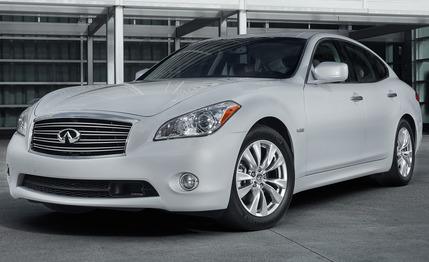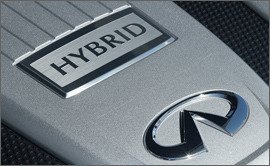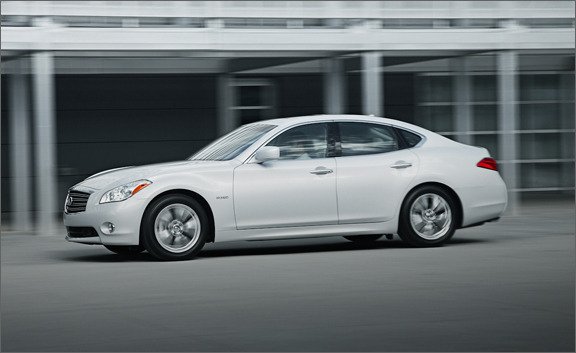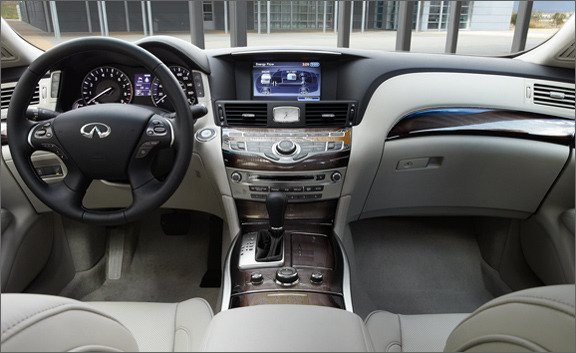
 First Drive Review
First Drive Review
This March, Infiniti will launch its 32-mpg M35h into the luxury hybrid-sedan segment, a niche only slightly larger than the market for cars with square wheels. Right now, the sales leader is the $58,925 Lexus GS450h, which was outsold last year by Rolls-Royce.
With a base price of $54,575, the Infiniti M35h is at least slightly cheaper than the Roller and the Lexus. The 360-hp M35h also is a technical curiosity and, in these days of rapidly rising fuel prices, possibly a portent of the future. Its partly electrified powertrain is sure to appear in other rear-drive cars based on Nissan’s FM platform. All Infinitis, except for the monstrous QX56, are potential candidates.
Hybrid How?
The M35h’s headline technology, the Infiniti Direct Response Hybrid system, is mainly found in its JATCO-supplied seven-speed automatic. Aside from not having a torque converter—there is an electric motor in its place—this is the same basic transmission as is used in the conventionally powered M models. It has two clutch sets: a dry one between the engine and electric motor and a wet pack aft of the transmission.


During driving, the clutches open and close as necessary to allow the electric motor to power the car independently of the gas engine, start and stop the engine at speed, assist the engine during acceleration, provide regenerative braking during deceleration, and, in the case of the rear clutch pack, smooth the lumpy transition between pure-EV mode and gasoline-hybrid mode.
Like the engines powering most other hybrids, the 302-hp, 3.5-liter V-6 in the M uses Atkinson-cycle valve timing. This strategy increases efficiency at the expense of power by leaving the intake valves open longer, which effectively shortens the compression stroke relative to the power stroke. The enhanced power stroke means the fuel is used more completely and less of it is required to achieve a given power demand.
As with Nissan’s electric Leaf, the M35h’s lithium-ion battery pack uses the company’s proprietary laminated-cell configuration, which means the cells are rectangular sheets instead of cylinders. This is better for keeping pack temperatures—and internal resistance—down. At 1.4 kWh, the M35h’s pack is considerably smaller than the Leaf’s (24 kWh), and Infiniti says the M35h can go 1.2 miles on electric power alone.
We turned a few miles in an M35h around the suburbs of Los Angeles and found that the essential M-ness survives the pile-on of about 270 pounds attributed to the 67-hp electric motor and its 346-volt battery pack. That means the M’s firm ride and swift steering remain as crisp as fresh iceberg lettuce, although the body does clop down a little heavier over pavement heaves and squirm around slightly more in corners as the extra pounds do their Newtonian-motion dance.
A New Interpretation of “Drag” Racing
Having been told that the rear-drive-only M35h will accelerate to 62 mph purely under electric power, we immediately tried it out. The conclusion: Infiniti may not be lying, but you need the feathery touch of an angel on the gas, a surface as smooth and flat as glass, and the patience of a monk. We only made it to about 30 mph before the engine switched on, and that was on a quiet back street where we could safely accelerate at the rate of a Segway pulling a horse trailer. Postal workers strode past us.


Infiniti claims that, under normal conditions—what is normal, anyway?—the car is able to drive in electric-only mode for as much as 50 percent of the time. Although the M35h seemed to spend much more time burning gas than electrons, we were flabbergasted by the stats that the computer gave us on the completion of our short drive. In 33.7 miles of mostly city stop-and-go driving, the M ran in electric mode for 14.2 of them. That is indeed pretty close to 50 percent.
Somehow, though, our fuel-economy average was only 23.2 mpg. The EPA estimates consumption of 27 mpg city and 32 highway against the M37’s 18/26. Of course, our mileage would have been better were we not trying to get a sense of whether Infiniti’s claim that the M35h will hit 60 mph in under six seconds is remotely valid. It certainly feels that quick, bustling to higher speeds with the enthusiasm of the M37—which accelerates to 60 in 5.5 seconds—although we won’t know for certain until we hang test gear onto it.
Unassuming Hybrid—for Better or for Worse
More important, the M35h’s operation is fairly seamless, which is surprising, considering how thoroughly electrified the car is. The steering is itself a hybrid, utilizing electric and hydraulic systems. Similarly, the brakes are actuated by an electric motor generating hydraulic pressure. Although the brakes can rip your dentures loose if you’re not judicious with the pedal, the system feels more or less natural—at least by Infiniti standards. Just the faintest of shudders can be felt when the transmission transitions from pure-EV to gasoline mode, and the brakes still feel linear and direct despite the system’s by-wire complexity and added effect of the regenerative braking.
Despite all the whiz-bangery going on under the skin, the M35h looks identical to the M37, except for its rump badge. Even the wheels are the same. It’s a risky maneuver by Infiniti, considering that many hybrid customers like to advertise their greenness, but the company says buyers in this class like to be more subtle. Maybe. Let’s face it: At its price, the M35h isn’t going to sell like hotcakes. A few well-heeled buyers interested in technology and talking about being green will take home this wonder widget of advanced technology, and their neighbors will likely never notice. Maybe they should have held out for an electric Rolls-Royce.

